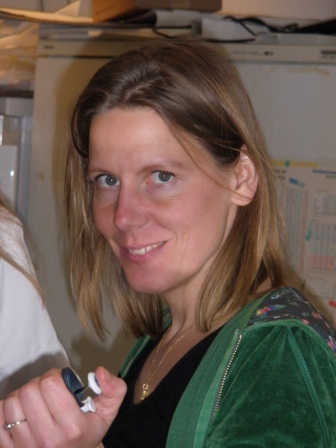Research Interests
Subtle gene modification by single-stranded oligonucleotides
 Marieke Aarts |
 Rob Dekker |
 Marleen Dekker-Vlaar |
 Sandra de Vries |
 Anja van der Wal |
We have developed an alternative route to subtle gene modification in mouse embryonic stem cells (ESC), which involves the use of small single-stranded DNA oligodeoxyribonucleotide sequences (ssODN) consisting of ±35 nucleotides complementary to the target gene, except for the one or few nucleotides to be modified (Dekker et al., 2003).
The key observation was that DNA mismatch repair (MMR) provides a strong barrier to ssODN-mediated substitution, insertion or deletion of a single or a few nucleotides (Dekker et al., 2003). We have developed strategies to circumvent this problem based on the different mismatch recognition specificities of the MSH2/MSH6 and MSH2/MSH3 protein dimers.
GENE KNOCKOUT (Dekker et al., 2005)
Four-nucleotide insertions are predominantly recognized by the MSH2/MSH3 dimer and can therefore be readily introduced in Msh3-/- cells.
As Msh3-/- ESC do not show an overt mutator phenotype (De Wind et al., 1999), these cells are particularly suitable for ssODN-mediated gene disruption.
CODON SUBSTITUTION (Aarts et al., 2006)
Base substitutions are recognized by both heterodimers.
We therefore reduce the level of MSH2 in wild-type cells for a few days by transient expression of a short-hairpin Msh2 RNAi sequence.
During this period, cells are permissive for ssODN-mediated substitution of 3-4 nucleotides. This allows us to replace single codons at any location in the genome.
Transient suppression of MSH2 level raised the efficacy of “oligo targeting” several hundred fold, reaching frequencies of 10-5 to 10-4. To purify modified cells from the vast excess of non-modified cells, we seed ssODN-exposed ESC cultures in 96-wells plates at a density of ~5000 cells per well. Subsequently, we use sensitive Q-PCR to identify wells containing mutant cells. Cells from positive wells are again seeded in 96-wells plates, now at lower density. After three rounds of enrichment, single cells are plated to obtain pure clones of modified cells.
Oligo targeting is an attractive alternative to current gene modification strategies, only requiring sequence information to design the oligonucleotide and primers for PCR-mediated identification of the gene modification. To improve the efficacy of oligo targeting, we have studied the mechanism and obtained strong evidence that ssODNs become physically integrated into the host genome during DNA replication (Aarts et al., 2010b). Consistently, inhibition of transcription or RNAi-mediated suppression of proteins involved in homologous recombination, non-homologous end joining, translesion synthesis, post-replicative repair and DNA damage signaling did not affect the targeting efficacy. These results indicate that neither transcription nor any DNA damage repair mechanism (except MMR) is essential for or detrimental to ssODN-directed gene modification (Aarts et al., 2010a). However, we found that ssODNs containing chemical modifications (PTO) induced a strong DNA damage response impeding the proliferative capacity of targeted cells (Aarts et al., 2010b). In contrast, unmodified ssODN were not harmful to cells and yielded higher targeting efficiencies than PTO-modified ssODN.
One of our mutant ESC (RbN750F) was used to generate the first mutant mouse line that was created via ssODN-mediated gene targeting (Aarts et al., 2006). We have now generated half a dozen of mouse lines carrying single-codon substitutions in Msh2 or p53 and are studying the phenotypic consequences.